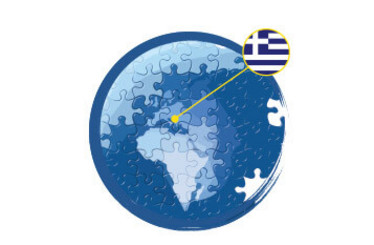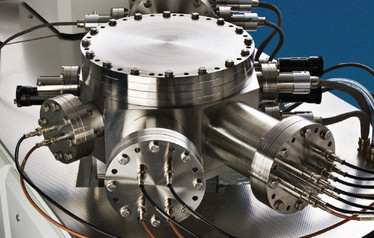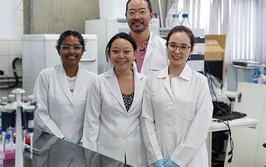CSI: Geographical Jigsaw
Can isotope analysis uncover enough pieces to build a better picture in a truly cold murder case?

The body of a young woman who had been murdered was recovered from under the I-75 Lake Panasoffkee bridge in Florida back in 1971. Lack of evidence meant that the victim was unidentified; she became known simply as ‘Little Miss Lake Panasofkee’. Her body was exhumed for further investigation in 1986, and has been kept at the University of Florida (UF) ever since.
In spring 2012, the detective working on the case, Darren Norris, and Erin Kimmerle, a forensic anthropologist at the University of Southern Florida, contacted George Dimitrov Kamenov (UF) for some serious analytical support. Kamenov’s research uses Sr, Pb, O and C isotope analysis to decipher ancient human migration patterns. Could the techniques geo-reference their unsolved case? “In ancient times, people likely consumed local food and water, so their teeth and bones tend to record the local environment signal. Today, our food, and in some cases even water, comes from different places. That’s a big problem,” says Kamenov.
The Analytical Scientist spoke with George Kamenov to find out more.
Does our peripatetic lifestyle present insurmountable problem?
The ‘archaeological’ approach does not work particularly well in modern cases but some modern activities, such as putting lead into gasoline, leave small clues. Everybody’s teeth contain some Pb from leaded gasoline; while the Pb additive has been banned, it remains in the soil and because the USA and Europe used lead from different ore deposits, their distinct Pb isotopes have inadvertently created an environmental marker. I measured Pb isotopes in the victim’s teeth and bones and the data was representative of a European Pb signal – the first indication that she was probably a foreigner. No wonder Florida locals failed to identified her…

Multi-collector of the Nu Plasma II ICP-MS used in the research. Image courtesy of Nu Instruments.
What analyses did you perform and why?
Sr, Pb, C, N, and O isotope analysis. Each of these isotope groups provides different information, so the combinatorial data offered the best chance of success.
I asked my colleague Jason Curtis to measure C and N isotopes in her hair. C isotopes showed a shift towards heavier δ13C in the latest hair growth (closest to the roots) compared to lighter δ13C at the hair tips. This is indicative of a shift from a wheat-based to a corn-based diet in the last few months of her life. Corn is more commonly consumed in the USA than in Europe.
We concluded that Little Miss Lake Panasoffkee was born and grew up in Europe and probably came to the USA several months before her death. To be more specific about where in Europe, we measured Sr and O isotopes in her teeth and bone. O isotopes showed relatively heavier δ18O values, which points to a southern Europe origin – close to a major water basin, perhaps the Mediterranean Sea. Sr isotopes showed a variable, somewhat bi-modal distribution that could represent a dietary change between early childhood and adolescence, or migration. On the other hand, such bimodal distribution is often seen in regions with complex geology, such carbonate rocks and old metamorphic rocks. Part of Greece, south of Athens, has such complex geology. When I compared the teeth sample Pb isotopes to published Pb isotopes for this part of Greece, there was a good match.
Where did that lead?
We considered the proximity of Tarpon Springs, the largest “Greek” town in the USA, to the place where the victim was found, and decided that Greek heritage was a likely scenario. The detective decided to publicize the case in Greek publications – hopefully some new information will emerge.
What instrumentation did you use?
Pb and Sr isotope analyses were conducted on a Nu-Plasma MC-ICP-MS (Nu Instruments, UK). The big advantage of this instrument (compared to traditional ICP-MS) is that it is equipped with multiple collectors (MC), allowing signals from multiple isotopes to be collected simultaneously. For example, Sr has four isotopes (84, 86, 97, 88), and so does Pb (204, 206, 207, 208), so we can use four detectors to collect the signals for all isotopes for each element.
To achieve high precision we also need to correct for instrumental mass-bias. For Sr, we use the internal isotope pair, 86Sr/88Sr (this ratio is fixed in nature) to correct the 87Sr/86Sr ratio – the ratio of interest for the cold cases studies). Pb does not have stable isotope pair, so we used a Tl normalization technique by adding 205Tl/203Tl with a known ratio to each sample. For Pb measurements, we use seven detectors (four for Pb isotopes, two for Tl, and one for Hg202 to correct for presence of Hg204, if any). This way, we can get high-precision data – far better than traditional thermal-ionization MS (TIMS) data.
Another advantage of MC-ICP-MS over TIMS is rapid analysis – several minutes versus hours. The main disadvantages of the MC-ICP-MS are its price – close to a million dollars, depending on the model and configuration – and the need for dedicated personal and temperature controlled, clean lab space required. Operating costs are in the tens of thousands of dollars just for lab supplies and gases.
O and C isotopes were measured on Finnegan MAT 252 gas mass spectrometer equipped with an online automated carbonate preparation (also a multi-collector instrument).
What were the main challenges? For example, was sample preparation an issue?
Sample preparation is not a technical issue; we’ve done a lot of previous work with archaeological human remains. (Of course, it is hugely important not to contaminate the sample!) But for both archaeological and cold case samples, it’s very time- and labor-consuming; samples need to be digested with nitric acid before separating Pb and Sr on ion-exchange columns ahead of analysis. It can take days, a week or longer to process a typical bone or tooth sample for Sr and Pb isotopes. C and O on teeth is somewhat easier and quicker, the sample is weighed and loaded into the mass spectrometer. Hair sample preparation is similar.
At present, the biggest challenge by far for cold-case work is interpretation of the data, especially as there are few databases available for comparison. For some cases, we need to look at the regional geology and figure out possible isotope signals. For example, a person from Florida – an area dominated by carbonate rocks – is expected to have an Sr signal that is distinct from a person residing in an area of granitic rocks. Further complications are caused by anthropogenic influence and variability in food and water supplies.
What are the limitations to this kind of investigation? For example, in terms of percentage certainty?
Honestly, I can’t really estimate. It is certainly more of a qualitative conclusion. In the case of Little Miss Lake Panasoffkee, I would estimate there is a 60-70% chance that she was from Greece. Despite the uncertainty, at least the detectives now have a plausible explanation for the lack of local leads and their inability to match to a missing person.
What is the future of such advanced mass spec techniques in forensic analysis? How could isotope analysis be applied in other fields?
I think there is still much we can learn from MS data. In addition to the isotopes that we used for this cold case, we can measure other non-traditional isotopes like Ca, Mg and Fe. It is not yet clear what such isotope data could reveal, but pilot work shows, for example, distinct Fe isotope ratio splits between genders and in people with some blood diseases. Ca and Mg analysis can potentially provide dietary information.
Trace and ultra-trace elemental analyses offers another forensic application of MS. For example, a pilot set of human ash samples that we ran a few years ago revealed a Gd anomaly in people who had been investigated by MRI. Such information could be useful in forensic investigations. In addition to human cases, isotopes and trace elements measured by advanced mass-spectrometry techniques can be used to trace the origin of archaeological artifacts, food, water, or wine.

Rich Whitworth completed his studies in medical biochemistry at the University of Leicester, UK, in 1998. To cut a long story short, he escaped to Tokyo to spend five years working for the largest English language publisher in Japan. "Carving out a career in the megalopolis that is Tokyo changed my outlook forever. When seeing life through such a kaleidoscopic lens, it's hard not to get truly caught up in the moment." On returning to the UK, after a few false starts with grey, corporate publishers, Rich was snapped up by Texere Publishing, where he spearheaded the editorial development of The Analytical Scientist. "I feel honored to be part of the close-knit team that forged The Analytical Scientist – we've created a very fresh and forward-thinking publication." Rich is now also Content Director of Texere Publishing, the company behind The Analytical Scientist.

















